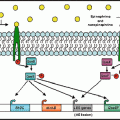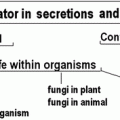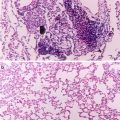Fig. 14.1
From: Probiotic Lactobacillus reuteri Attenuates the Stressor-Enhanced Severity of Citrobacter rodentium Infection. Probiotic intervention reduces stressor-enhanced anxiety-like behavior and significantly reduces circulating IL-6 at the peak of infection. Mice were restrained for 1 day and then orally challenged with C. rodentium. Restraint continued for 6 days postchallenge, during which the drinking water was supplemented with either VEH or L. reuteri, beginning 1 day prior to restraint. Prior to sacrifice, mice were tested by the open field test and recorded for 5 min. Locomotion was quantified by the total number of lines crossed and the amount of time spent in the center of the open field. (a) There were no changes in the total number of lines crossed in either stressor-exposed group. Sample sizes were as follows: n = 12 (CON/VEH), n = 12 (CON/L. reuteri), n = 6 (RST/VEH), and n = 4 (RST/L. reuteri). (b) There was an increase in anxiety-like behavior, as evidenced by a reduction in the time spent in the center of the open field, in VEH-treated, stressor-exposed mice, which was restored with L. reuteri treatment. *P < 0.05 between CON/VEH and RST/VEH groups as assessed by Student’s t test with the Bonferroni correction factor as a post hoc test. Sample sizes were as follows: n = 18 (CON/VEH), n = 18 (CON/L. reuteri), n = 9 (RST/VEH), and n = 9 (RST/L. reuteri). Cytokine levels were determined by a Bio-Plex assay. (c) Circulating IL-1β was reduced by stressor exposure on day 12 postchallenge, and L. reuteri failed to modulate this reduction. *ANOVA main effect for group (CON versus RST; P = 0.01). Sample sizes were as follows: n = 13 (CON/VEH), n = 11 (CON/L. reuteri), n = 7 (RST/VEH), and n = 7 (RST/L. reuteri). (d) Circulating IL-6, however, was significantly increased by stressor exposure in VEH-treated mice on day 12 postchallenge. Probiotic intervention with L. reuteri reduced stressor-enhanced circulating IL-6 levels. *P < 0.001 between CON/VEH and RST/VEH groups. Student’s t test with the Bonferroni correction factor was used as a post hoc test. Sample sizes were as follows: n = 14 (CON/VEH), n = 13 (CON/L. reuteri), n = 7 (RST/VEH), and n = 6 (RST/L. reuteri). Figure originally published in: Amy R. Mackos, et al. Infect Immun. 2013 September;81(9):3253–3263
14.6 Perinatal Stressor-Induced Alterations to Microbiome Development
Scientific interest in the connection between stress and the human microbiome, and its impact the developing fetus is increasing, but still in an early stage. The microbiota may have exaggerated and prolonged effects when perturbed during gestation or early in infancy. Pregnant rhesus monkeys exposed to auditory stressor during their 24 week gestation demonstrated an increased level of cortisol, and their offspring demonstrated significantly lower levels of lactobacilli. In addition, though not intentionally exposed to pathogen, the offspring of stressed mothers demonstrated decreased resistance to Shigella flexneri, an endemic pathogen within the colony (Bailey et al. 2004).
While it is recognized that prenatal gestation may impact the development of the microbiota, leaving the offspring susceptible to infection, the effects of gestational stressors may actually be manifest even prior to infant development. Stress is a well-known risk factor that affects many factors that have been associated with preterm birth, including the immune response, inflammation, and the HPA axis (Shapiro et al. 2013). These factors may be significantly impacted by the commensal microbiota (Gur et al. 2015). Microbial invasion of the amniotic cavity and subsequent host inflammatory response is a prime suspect in the causation of PTB (DiGiulio 2012; Goldenberg et al. 2000; Goncalves et al. 2002). Microbes are thought to invade both hematogenously and from the lower gut or genital tract (DiGiulio 2012). While genital pathogens and their capacity to invade the amnion and induce PTB have been well studied, the source of hematogenous microbes and their ability to invade the amniotic cavity remains unclear. Oral microbes have been implicated, based largely on a study that demonstrated that the placenta harbors a commensal microbiome community structure that is reflective of oral microbial communities (Aagaard et al. 2014). While it is known that stressor exposure can change the composition of the gut microbiota, and the ability of microbes to translocate from the lumen of the intestines to the interior of the body (Bailey et al. 2006, 2010; Galley et al. 2014b), the relationship between the various indigenous microbial communities and the intrauterine environment is not well understood.
Animal studies support the idea that stress-induced alterations in neonatal life and gut microbiome can have substantial impact on long-lasting health. Rat offspring deprived of their mother demonstrated increased permeability of colonic mucosa and increased bacterial adherence to colonic tissue and spleen translocation. The HPA axis likely mediated this effect, as the negative sequelae were prevented by injecting rat pups with a corticotropin-releasing hormone receptor antagonist during maternal separation (Gareau et al. 2006). A swine model for perinatal disturbance was adopted with oral antibiotics to sows. Short- and long-term changes were seen in paracellular permeability (Boudry et al. 2011). Together, these studies suggest that altering either the maternal or perinatal microbiota has long lasting implications on the gut of the offspring, as well as immunological repercussions. Mechanisms for this change are still being evaluated, but one potential route is that perinatal changes in bacterial colonization alter gastrointestinal heat shock protein expression with permanent implications on health (Lalles 2012).
14.7 Towards an Integrative Understanding of Stress, Microbiota, and Immunity
The significance of stressor-induced changes in the commensal microbiota is only beginning to be understood. The role of the microbiome in human disease has expanded from the intestines to other organ systems; the biological mechanisms and underpinnings through which the microbiome exerts its effects are only beginning to be understood. Microbiota-induced alterations in the host inflammatory response are almost certainly important for stressor-induced immunopathology. The ability of stressors to impact host inflammatory responses is well documented in both rodents and humans, even in the absence of overt infection (Brydon et al. 2006; Steptoe et al. 2007; Coussons-Read et al. 2007; Bierhaus et al. 2003; Avitsur et al. 2002; Bailey et al. 2007; Engler et al. 2008; Stark et al. 2001). The questions of why and how the immune system is activated during a stress response, even in the absence of antigen challenge, have long been postulated. Given what we now know regarding the effect of stress on the microbiome, it is hypothesized that stressor-induced changes in the commensal microbiota activates the immune system, resulting in stress-induced elevations in cytokines. Demonstrating how these alterations occur, and determining how to optimize pre- and probiotic interventions that can shift an individual from disease to health is the next challenge for this field to tackle.
References
Allen RG, Lafuse WP, Galley JD, Ali MM, Ahmer BM, Bailey MT (2012a) The intestinal microbiota are necessary for stressor-induced enhancement of splenic macrophage microbicidal activity. Brain Behav Immun 26:371–382PubMedCentralCrossRefPubMed
Allen RG, Lafuse WP, Powell ND, Stiner-Jones LM, Webster Marketon JI, Sheridan JF, Bailey MT (2012b) Stressor-induced increase in microbicidal activity of splenic macrophages is dependent upon peroxynitrite production. Infect Immun 80:3429–3437PubMedCentralCrossRefPubMed
Bailey MT, Coe CL (1999) Maternal separation disrupts the integrity of the intestinal microflora in infant rhesus monkeys. Dev Psychobiol 35:146–155PubMed
Bailey MT, Kierstein S, Sharma S, Spaits M, Kinsey SG, Tliba O, Amrani Y, Sheridan JF, Panettieri RA, Haczku A (2009a) Social stress enhances allergen-induced airway inflammation in mice and inhibits corticosteroid responsiveness of cytokine production. J Immunol 182:7888–7896PubMedCentralCrossRefPubMed
Bailey MT, Kinsey SG, Padgett DA, Sheridan JF, Leblebicioglu B (2009b) Social stress enhances IL-1beta and TNF-alpha production by Porphyromonas gingivalis lipopolysaccharide-stimulated CD11b+ cells. Physiol Behav 98:351–358PubMedCentralCrossRefPubMed
Bailey MT, Dowd SE, Parry NM, Galley JD, Schauer DB, Lyte M (2010) Stressor exposure disrupts commensal microbial populations in the intestines and leads to increased colonization by Citrobacter rodentium. Infect Immun 78:1509–1519PubMedCentralCrossRefPubMed
Stay updated, free articles. Join our Telegram channel

Full access? Get Clinical Tree






